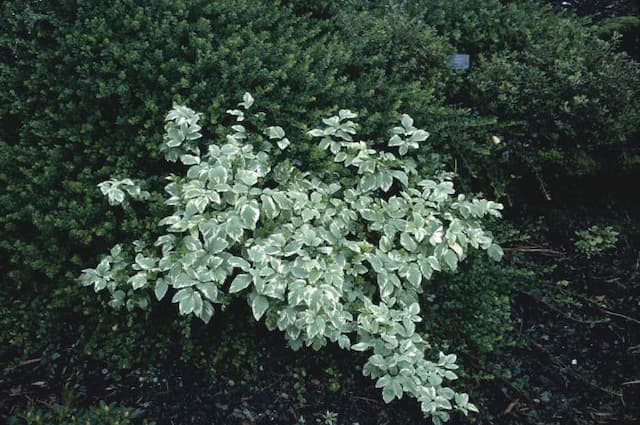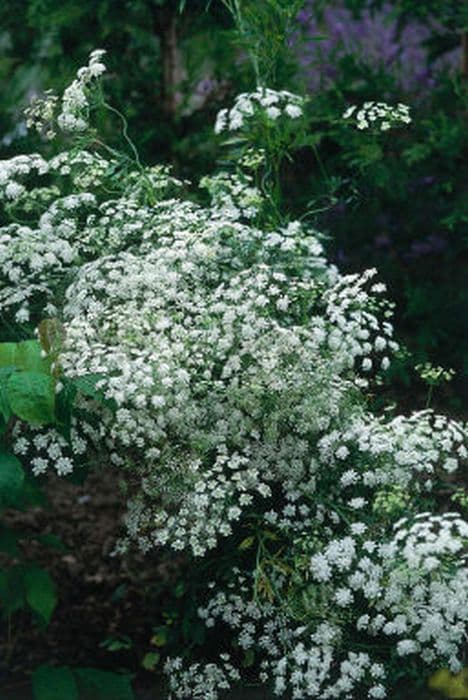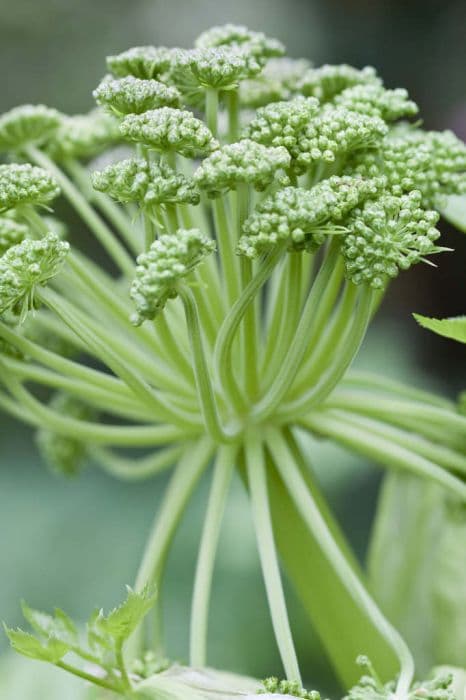Giant Sea Holly Eryngium pandanifolium 'Physic Purple'

ABOUT
Eryngium pandanifolium 'Physic Purple,' commonly known as Giant Sea Holly, is an eye-catching perennial known for its striking foliage and unique flower heads. The plant features a rosette of arching, sword-shaped leaves that are a deep green color with purplish or bluish tinges. The texture of the leaves is leathery, and they may have spiny-toothed edges, lending a somewhat rugged and exotic appearance to the plant. The Giant Sea Holly is especially admired for its flower heads, which are composed of small, metallic purple to bluish flowers tightly packed into cone-shaped clusters. These flower heads are surrounded by spiky bracts that share the same intense purplish hue, giving the whole bloom a thistle-like appearance. The contrast between the colorful bracts and the steel-blue flowers creates a dramatic visual impact. The overall appearance of Giant Sea Holly is bold and architectural, with its stiff, upright stems that hold the flower heads high above the foliage, and the rosette of arching leaves below. This plant is often valued in gardens for its distinctive color palette and its ability to add vertical interest, as well as for its resistance to drought and poor soils. Its unique form and color make it a favorite for use in both fresh and dried flower arrangements.
About this plant
 Names
NamesFamily
Apiaceae
Synonyms
Giant Rhubarb, Physic Purple Sea Holly, Purple Button Snakeroot
Common names
Eryngium pandanifolium.
 Toxicity
ToxicityTo humans
The Eryngium pandanifolium, commonly known as giant sea holly, does not have a known toxicity to humans. There are no well-documented cases of poisoning or adverse effects directly related to the ingestion of this plant by humans. It is generally considered to not be poisonous, but as with any plant not typically consumed as food, it is advisable to exercise caution and avoid ingestion.
To pets
Similar to its effects on humans, the giant sea holly is not widely known to be toxic to pets. There is little information suggesting that animals, such as cats and dogs, would experience poisoning from ingesting parts of this plant. However, as with any non-food plant, it is recommended to prevent pets from consuming it to avoid any potential risk or unexpected reactions.
 Characteristics
CharacteristicsLife cycle
Perennials
Foliage type
Evergreen
Color of leaves
Green
Flower color
Purple
Height
6 feet (1.83 meters)
Spread
2 feet (0.61 meters)
Plant type
Herb
Hardiness zones
8
Native area
Argentina
Benefits
 General Benefits
General Benefits- Aesthetic Appeal: Adds striking visual interest to gardens and landscapes with its bold purple foliage and architectural form.
- Drought Tolerance: Once established, it has low water requirement which makes it suitable for xeriscaping and draught-prone areas.
- Low Maintenance: Requires minimal care once established, making it ideal for gardeners seeking a low-maintenance plant.
- Attracts Wildlife: Flowers can attract a variety of pollinators such as bees, providing a habitat and food source for them.
- Durability: Its robust nature makes it resistant to diseases and pests, reducing the need for chemical treatments.
- Long Blooming Period: Offers a long season of visual interest, from its summer blooms to attractive seed heads in fall and winter.
- Soil Adaptability: Can thrive in a wide range of soil types, including poor soils, as long as they are well-drained.
- Unique Texture: Its spiky leaves and bracts add a unique textural element to garden compositions.
 Medical Properties
Medical PropertiesThis plant is not used for medical purposes.
 Air-purifying Qualities
Air-purifying QualitiesThis plant is not specifically known for air purifying qualities.
 Other Uses
Other Uses- Giant Sea Holly can serve as a barrier plant due to its spiny leaves, which can deter animals and unwelcome visitors from moving through a landscape or garden.
- It can be used in dried flower arrangements; the striking flowers and bracts retain their shape and color when dried.
- The plant's rigid structure can be used as a natural support for floppier plants or flowers in a garden setting.
- Giant Sea Holly can be incorporated into xeriscape landscaping, aiding in water conservation due to its drought-resistant properties.
- This plant can be used as a striking focal point in modern landscape designs, thanks to its unusual color and architectural form.
- Giant Sea Holly is ideal for coastal gardens as it is tolerant to salt and can be used to stabilize sandy soil.
- The plant's tendency to self-seed can be used for naturalizing wild or meadow areas within a larger landscape design.
- Its spiky appearance can be used to create textural contrast with soft, fine-foliaged plants in a garden palette.
- The stems of Giant Sea Holly can be utilized in artisanal crafts, such as wreath making, for their unique texture and color.
- As an educational tool, the plant can be used to teach about pollinator-friendly practices since it attracts bees, butterflies, and other beneficial insects.
Interesting Facts
 Feng Shui
Feng ShuiThe Giant Sea Holly is not used in Feng Shui practice.
 Zodiac Sign Compitability
Zodiac Sign CompitabilityThe Giant Sea Holly is not used in astrology practice.
 Plant Symbolism
Plant Symbolism- Unique Beauty: Eryngium pandanifolium 'Physic Purple', commonly known as Giant Sea Holly, often symbolizes unique beauty due to its striking purple cones surrounded by spiky bracts, which stand out in any garden setting.
- Protection: The thorny and spiky appearance of Giant Sea Holly is frequently associated with protection, representing a barrier against negative forces and the ability to safeguard one's space.
- Independence: With its robust and hardy nature, Giant Sea Holly can symbolize independence, suggesting strength, resilience, and the ability to thrive in challenging conditions.
- Dignity and Nobility: The regal color and upright stature of Giant Sea Holly often lend themselves to associations with dignity and nobility, suggesting poise and a commanding presence.
 Water
WaterThe Giant Sea Holly should be watered thoroughly, allowing the water to penetrate deeply into the soil to encourage deep root growth. It's best to water the plant once every one to two weeks, depending on the climate and weather conditions, ensuring the soil has dried out between waterings. For each watering session, you should provide approximately 1 gallon of water to sufficiently saturate the root zone without causing waterlogging. During hotter months, you may need to increase the frequency of watering, but always check the soil moisture level first to avoid overwatering.
 Light
LightThe Giant Sea Holly thrives best in full sunlight where it can receive at least six hours of direct light daily. It should be placed in a spot that offers unobstructed access to sunlight, such as a southern or western exposure if indoors or an open area with plenty of sun if planted outdoors. Avoid shady locations as insufficient light can hamper the plant's growth and flowering potential.
 Temperature
TemperatureThe Giant Sea Holly prefers a temperate climate and can handle temperatures as low as 20°F and as high as 90°F. However, the ideal temperature range for this plant is between 60°F and 75°F. It's important to protect the plant from frost and prolonged exposure to extreme heat to ensure its vitality.
 Pruning
PruningPruning the Giant Sea Holly is recommended to remove spent blooms and encourage further flowering. Prune the plant after blooming has finished, typically in the late summer or early fall. This is also the time to cut back any dead or damaged foliage to maintain plant health and appearance. Pruning should be done carefully, using clean, sharp tools to make precise cuts.
 Cleaning
CleaningAs needed
 Soil
SoilGiant Feather Grass thrives best in well-draining soil with a mixture that includes sharp sand or gravel to ensure proper drainage. A soil pH level around 6.0 to 7.5 is preferable.
 Repotting
RepottingGiant Feather Grass typically doesn't require frequent repotting. Repot every 3 to 4 years or if you notice that the plant has outgrown its container.
 Humidity & Misting
Humidity & MistingGiant Feather Grass prefers moderate humidity levels but is quite adaptable and can tolerate a range of humidity conditions.
 Suitable locations
Suitable locationsIndoor
Place in bright light, avoid overwatering.
Outdoor
Full sun, well-draining soil, tolerant to drought.
Hardiness zone
8-10 USDA
 Life cycle
Life cycleEryngium pandanifolium 'Physic Purple', commonly known as giant sea holly, begins its life cycle as a seed, which requires cold stratification to simulate winter conditions for germination. Once conditions are appropriate, the seed germinates and a seedling emerges, characterized by basal rosette leaves. As the plant matures, it develops long, spiky foliage resembling that of a pandanus, and a strong central stem that will eventually bear flowers. During the flowering stage, typically in summer, the plant produces distinctive purple, cone-shaped flower heads surrounded by spiky bracts, which are highly attractive to pollinators. After pollination, seeds develop and are disseminated, either by wind or wildlife, to begin a new cycle. In colder climates, the plant dies back in winter, but will regrow from its rootstock with the arrival of spring.
 Propogation
PropogationPropogation time
Spring-Early Summer
Eryngium pandanifolium 'Physic Purple', commonly known as Giant Sea Holly, is often propagated by seeds. The best time to propagate this plant by seeds is in the late fall to early spring. Sow the seeds on the surface of a well-draining seed starting mix, pressing them lightly into the soil without covering them as they need light to germinate. Keep the soil moist but not waterlogged, and maintain a temperature around 70°F (21°C). Germination can be erratic and may take several weeks. Once the seedlings have developed a set of true leaves and are large enough to handle, they can be transplanted into individual pots before eventually planting them out in their permanent positions. It's important to note that seeds collected from 'Physic Purple' may not come true to type due to hybridization.









